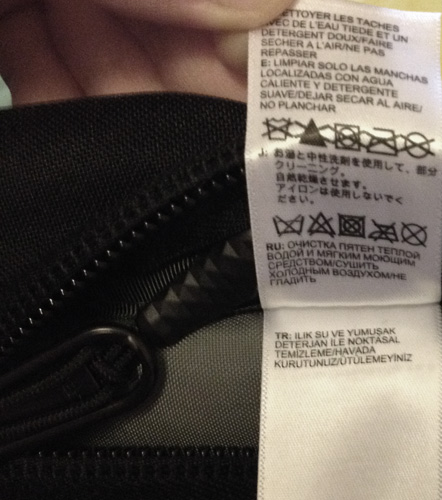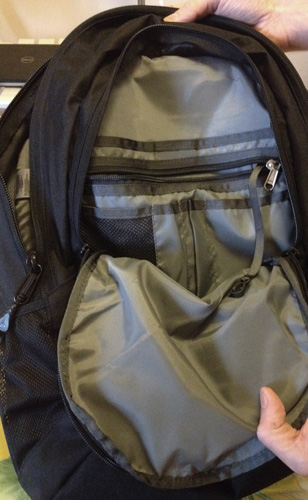
If you’re an outdoor enthusiast, you know that having a quality backpack is not just about carrying your belongings, but also about ensuring that you have everything you need for your next adventure.
Hikers, mountaineers, campers, and travelers all rely on their backpacks to store and transport their gear.
And when it comes to backpacks, The North Face is a brand that stands out for its quality and durability.
In this guide, we’ll be discussing how to clean a North Face backpack step by step.
This includes popular models like the Borealis, Surge, Jester, and Recon, so you can keep your backpack looking and smelling fresh for your next trip.
Let’s get started!
1. Is Washing a North Face Backpack Necessary?
Before we dive into the washing process of a backpack by The North Face, it’s important to note that washing a backpack is generally not recommended. Quality backpacks are designed to withstand tough conditions and often come with a DWR coating to repel water and keep items inside dry.
Additionally, there is a risk of damage during the washing process, especially if a washing machine or harsh detergents are used. To avoid these issues, we’ll discuss the best ways to clean a backpack in the following paragraphs.

The North Face backpack care instructions tag
Spot cleaning is the most recommended method, as advised by The North Face in their Product Care page. They do not recommend fully washing or submerging their backpacks in water.
However, if spot cleaning isn’t enough to remove all the dirt and grime, a proper wash may be necessary. It’s important to note that this should only be done in serious situations where the backpack is unrecognizable from its original state.
Read also: How To Wash a North Face Jacket (Down, Fleece, Gore-Tex)
2. Before Washing a North Face Backpack
What You’ll Need
Below is a brief list of the necessary items required to safely and effectively wash your The North Face backpack:
- Dirty The North Face backpack;
- A sink, basin, or bathtub that is spacious enough to accommodate the backpack for washing;
- Mild non-bleach detergent;
- Paper towels, hand towels, or cloth;
- Toothbrush or soft brush;
- Hanger.
Before Starting Washing
Prior to washing your backpack, it’s crucial to ensure that there are no items left inside. Thoroughly check each pocket and compartment, and remove all contents.
Afterward, flip the backpack upside down, unzip all compartments, and shake it vigorously to remove any small or hard-to-reach debris that may be present. Once the backpack is completely empty, you can move on to the next step.
Brushing Off Dirt
It’s crucial to brush or wipe off any dirt from both the exterior and interior of the backpack before soaking it. Failing to do so can cause the dirt to stick to the fabric even worse once it gets wet.
To accomplish this, a soft brush or toothbrush can be used, as well as a dry paper towel. For larger areas, a paper towel is recommended, while a toothbrush is ideal for smaller crevices that require more attention.
It’s important to be gentle during this process to avoid scratching or damaging the surface of the backpack.
You might also like: Why Is The North Face So Expensive and Popular? Are Its Jackets Worth It?
3. The Wipe Down Method
The wipe-down method is a safe approach to cleaning any backpack, including those produced by The North Face. This method involves using minimal water and no detergents, thereby reducing the risk of damaging the backpack or its DWR coating.
Clean the Interior
Although not always necessary, cleaning the interior of the backpack is an effective way to maintain its appearance and ensure that no dust or dirt is stuck inside, which could complicate matters when wetting the backpack.
A paper or regular towel that can get dirty can be used for this purpose. The best approach is to dampen the cloth and then wring it out to eliminate any excess water. It’s important to use as little water as possible when cleaning the backpack.
Thoroughly wipe down each compartment and pocket until you’re confident that it’s clean.

The North Face backpack interior
Clean the Exterior
Once the interior is clean, you should determine whether spot cleaning is sufficient or if a more thorough cleaning is necessary.
If spot cleaning is the preferred method, using a damp cloth directly on the affected area is the easiest and recommended approach by The North Face. Spot cleaning is quick and avoids potential issues that may arise from fully washing a backpack.
However, if a quick clean of the entire backpack is desired, the same method of using a wet cloth or paper towel for the exterior will suffice. The cloth can be re-soaked as needed, but it’s important to wring out any excess water before use. It’s crucial to keep things as dry as possible up to this point.
Once this final step is complete, the backpack should be sufficiently clean and can be hung to dry.
Read also: 11 Brands like The North Face: Our Top Alternatives
4. The Soaking Method
If your backpack remains visibly dirty or if you’re not satisfied with the cleaning achieved by wiping it down with a damp cloth, the next step would be to soak it. To do this, fill a basin, sink, or bathtub with tepid water.
For the time being, avoid using any detergents or soaps. Soaking can typically clean a backpack without the need for detergents. Submerge the backpack in the water with all compartments and pockets opened to ensure thorough cleaning.
To ensure the success of this step, we recommend using a brush or toothbrush to reach the hard-to-reach areas. These tools can also be used lightly on the fabric to help remove any remaining dirt.
You might also like: 9 European Backpack Brands for Hiking and Outdoor Activities
5. Detergent Use
We strongly advise against resorting to this step, as there is no guarantee that even mild detergents won’t react negatively with the backpack and its DWR coating. This step should only be used when there are stubborn stains that won’t come off. If necessary, use a mild, bleach-free detergent.
We recommend using Nikwax products, which are specifically designed for fabrics treated with DWR products, or similar bleach-free alternatives. If these are unavailable, OxiClean™ or other mild powdered detergents may be used.
For this method, tepid water should also be utilized. Add the cleaner to the water first and mix it well to ensure it fully dissolves. Use as little as possible and avoid pouring it directly onto the backpack.
Once again, fully submerge the backpack in the water, ensuring the stained area stays underwater. Soak for several hours, depending on the severity of the stain. We suggest checking the backpack after the first 20-30 minutes to see if the stain is lifting. The shorter the time the backpack is submerged, the better.
After completing this step, it’s crucial to rinse the backpack thoroughly. Submerge it in clean water and rinse until no detergent residue is left. This can be determined when bubbles stop forming when the pack is shaken underwater.
Read also: 8 Italian Backpack Brands for Outdoor, Travel, and Casual Wear
6. Drying the Backpack
For drying the backpack, a hanger is required, and it should be hung in a location where it can dry slowly, such as a garage. While hanging it outside may speed up the drying process, it can cause the backpack to shrink, which should be avoided.
Do not use a dryer or any other fast-drying method, as they can damage the fabric and cause it to melt or shrink. For optimal results, hang the bag upside down, as this will allow water to drain out more quickly.
Read next: 8 German Backpack Brands that You’ll Love
7. Can You Use a Washing Machine to Clean a North Face Backpack?
If your washing machine has a hand wash program, it may be possible to wash the backpack at the lowest temperature setting and with the fewest number of spins, preferably using a laundry bag. However, we strongly advise against this approach, as it’s not worth the risk of damaging the backpack.
Read also: 8 Best French Backpack Brands: Our Favorites
